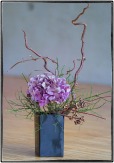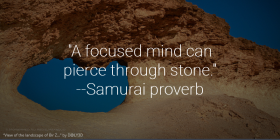In the last post, subtitled, “A New Language for Creative People,” I applied Samurai terms to the lives of creatives to show that those terms have relevance to writers, artists, composers, architects, and actors today, a thousand years  after “the tramp of warriors sounded like a thousand convulsions of the earth,” and “the shouts of warriors, the whistling of arrows, the thunder of the feet of foot soldiers and the hooves of chargers did not cease.”
after “the tramp of warriors sounded like a thousand convulsions of the earth,” and “the shouts of warriors, the whistling of arrows, the thunder of the feet of foot soldiers and the hooves of chargers did not cease.”
Do: The Concept of a “Way”
The Japanese “do” (pronounced “dough”), means “way,” short for “way of life” or “life path.” That a discipline is a Way is indicated by the do suffix at the end of a word. Thus kendo (ken, sword; do, way) means “sword Way,” or Way of the sword. Bu (warrior) do (Way), refers to the attitudes, behavior and life-style of the Samurai warrior.
In kyudo, the Way of the bow, no quiver is worn and the archer fires just one arrow. From this the archer is to learn daido, a “principle that operates in all things.” The archer is to come to value his life more fully, for each arrow is like the  totality of his life. You have but one life; thus you shoot but one arrow. The Samurai was taught, “The Way is your daily life.”
totality of his life. You have but one life; thus you shoot but one arrow. The Samurai was taught, “The Way is your daily life.”
A serious writer’s or artist’s life is a “Way,” for example, the Way of the Writer,” “the Way of Writing,” and “the Way of the painter or sculptor”– just as in Japan there is the Way of floral arrangement, the “Way of flowers,” and “The Way of tea.” It’s axiomatic that what applies to one  Way has application to all the other Ways. For example, a basis of the Way of the Warrior is showing courage in the face of adversity. And a writer or actor and painter too faces adversity and will benefit from having a warrior’s courage.
Way has application to all the other Ways. For example, a basis of the Way of the Warrior is showing courage in the face of adversity. And a writer or actor and painter too faces adversity and will benefit from having a warrior’s courage.
When creating is a Way you say to yourself, “I am full of unrealized potentials and special gifts that need to be developed, and am what I make of myself. I take full responsibility on myself and am choosing a creative’s life of my own free will. I have felt that creative calling for a long time. So many years and days allotted to me have passed and I believe I haven’t gotten far enough. I’m clear now and I have stores of energy in me that will make possible extraordinary achievements. My life now will be an existence that I’m designing to my own specifications. I have the conviction that the life I now envision is the life I was always meant to have.”
On the creative’s Way you’re committed to:
- Finding a best outlet for your talents
- Perfecting your aptitudes and skills
- Discovering and expressing yourself
- Creating beauty
- Expressing truth
- Communicating with a public
- Learning a discipline, becoming part of a tradition
- Prevailing over difficulty
- Developing and improving
- Being paid and/ or compensated in other ways such as through recognition and acclaim
- Finding pleasure in creating and the creatives’ life
Skills can be taught, but a Way can’t. There’s no searching for a Way. It comes to you on its own when you’re ready. And when it does come, you know. As a  child, you begin writing or drawing no differently than anyone else, but at some point—it could be at the age of five or a hundred and five–you begin creating more purposefully than other people. Then almost without being aware of how it happened, out of the processes of creating, gaining knowledge of your craft, and the craft’s world, and growing in skill, you are “taken” by it fully and completely and find yourself on the Way of the painter, writer, or actor, etc.
child, you begin writing or drawing no differently than anyone else, but at some point—it could be at the age of five or a hundred and five–you begin creating more purposefully than other people. Then almost without being aware of how it happened, out of the processes of creating, gaining knowledge of your craft, and the craft’s world, and growing in skill, you are “taken” by it fully and completely and find yourself on the Way of the painter, writer, or actor, etc.
The logical end of the creative’s Way is to become a Real Writer, or Real Painter, or Real dancer, and so forth—to become known by your family, friends, teachers, and audience, and to define yourself as “someone who is serious about creating.”
Let your work become a Way.
Mokuteki Hon’I: “Focus on Your Purpose’’
When as a person doing creative things you discover what you must accomplish with your talents and that becomes a major goal there comes something new and extraordinary into your existence. You’re electric with that rarest of qualities—intensity. Doing the work as well as you’re able becomes a Purpose.
The Samurai was taught, Mokuteki hon’I, “Focus on your purpose.” With a purpose your every act takes on power. Obstacles, once so intimidating, fall away because your purpose is more powerful than the obstacles. You feel a zest, a tingle. Your imagination is on fire. It is strength to be of one mind, complete and undivided, fully committed to a life with purposes.
When you make a purpose out of what a moment before was merely a responsibility, or a chore, or a duty by thinking, “This, what I am doing now, is  my purpose,” extraordinary achievements become possible. Impediments become light as feathers.
my purpose,” extraordinary achievements become possible. Impediments become light as feathers.
Begin every project and every day, every time you return to work after a break, with your purpose in mind. Say the words, “Focus on your purpose.” I can’t tell you how many times in my life I’ve said “Focus on your purpose” aloud to myself and been inspired by those words. Thousands.
Kufu: “Struggling, Wrestling, and Grappling with Something
Until a Good Solution Is Found”
I was interviewing people for a job that required the ability to write reports. While he wanted the job, Jack confided that he had a problem—writer’s block. Anyone who will apply for a writer’s job and be so honest as to tell the person doing the hiring that he has problems writing is my kind of guy. He told me more. “When I sit down to work, all that I want to say seems clear to me. But when I actually start I have a tough time. The ideas and words don’t come. I try, but after about an hour I give up. What do you think I should do?”
“Don’t quit after an hour,” I said.
The point I was making was a simple Samurai one. I was telling Jack to kufu his way out. Some problems are one-hour problems, others are two or five hour or longer problems.
Kufu. It’s a wonderful concept that applies equally to the small everyday tasks and problems in a creative’s life and to the big ones too. It means giving yourself completely to discovering the solution or to finding the way out of your difficulties and to your creative goal.
It means to struggle, to grapple, to wrestle until you find the solution. It is holding nothing back in reserve. It is closing ground on the problem and never retreating or hanging back. When you take the kufu, grapple-your-way-out approach, you know that somewhere ahead of you lies a breakthrough point, a moment when you will get the better of the creative problem or the task. It is there awaiting you. All you have to do is remain concentrated and focused on the goal.
“Who knows,” I told Jack, “but your breakthrough point could come at sixty-one minutes or seventy-five or may take days. If you give up after an hour,  you’ll never reach it. Kufu your way out of this writer’s block.”
you’ll never reach it. Kufu your way out of this writer’s block.”
Months later Jack came to tell me that he had gone back to his writing to try the kufu approach of staying with it, trying it again and again, no matter how long it took. Suddenly, he said, writing had become not totally effortless, but noticeably less difficult.
No one is spared resistances to the creative breakthrough experience. Jack continued to encounter concentration problems from time to time, but he had learned what many people never learn: the kufu spirit of staying with it until the problem is solved.
Makoto: “Sincerity”
Makoto is the Samurai precept of precepts and a concept of action that the Japanese of today value above all others. It is usually translated into English as “sincerity.” But it does not mean sincerity in the sense of “I’m sincerely pleased with our conversation.”
Makoto means putting absolutely everything you have, everything you are into an act—all of your heart, and all your spirit, mind, and all of your physical strength. To hold anything back in reserve or to hesitate in any way whatsoever is for the creator to act . . . insincerely.
Creative people are tremendously productive individuals who at their best practice makoto every day, putting all their talents, skills, and training into their work, holding nothing in reserve.
The Samurai terminology I’ve described in the last two posts express ideas that have been useful to creative people everywhere in the world as they all aimed so steadily at perfecting their skills and so devotedly pursued their Way.
© 2016 David J. Rogers
For my interview from the international teleconference with Ben Dean about Fighting to Win, click on the following link:
Order Fighting to Win: Samurai Techniques for Your Work and Life eBook by David J. Rogers
or
Order Waging Business Warfare: Lessons From the Military Masters in Achieving Competitive Superiority
or



Thank you for your writings David.
They’re terrific.
Best,
laura
(an appreciative reader)
LikeLike
Thank you for your comment, Laura. I appreciate your taking the time to let me know that you enjoy my work. Very kind of you.
LikeLike
Powerful message, David especially the imagery of the single arrow. Made me think of a parallel with digital photography versus using film. When we used to use film we took so much more care in composing the shot and photographing with precision and focus, not just shooting a whole quiver of arrows haphazardly in the hope of getting one acceptable shot.
LikeLike
Michelle, I too like the image of the single arrow representing our single lives. I’d never thought of your photography analogy, but I see you’re right. Lately I’ve had occasion to think of lost traditions and now another is using a camera. I can remember my father and his old box Kodak, and his lining us all up for the perfect shot.
Thank you for your comment. I’ve been thinking about you and am happy you wrote in. I wish you the best in this lovely holiday season.
LikeLike
Thank you David, all the best to you too! I will be thinking of your single arrow as I am out in the rose gardens with my camera!
LikeLike
I see from your latest post that you have been out in rose gardens, and I will be commenting there shortly.
LikeLike
Thank you for your “Mokuteki Hon’I”,David,
Writing these Great Concepts part 2,having a
fusion Ancient Japan-Modern English fusion.
I love these Concepts.
LikeLike
Marilucas, It is rather amazing I think how medieval Samurai concepts relate to the daily life of a writer like you here in Midwest America in the 21st century. When I think of you now I know you will be focusing on your purpose. A happy thought.
It was good having a chance to talk with you recently. I hope you and your family have happy holidays, Marilucas.
LikeLike
I love this post. It came at just the right time. My husband (visual artist) and I (writer, ingenue visual artist) always tease each other about not being REAL artists, as one of my students said, when he came to do a workshop at my school: “You’re not a REAL artist!” Being REAL is very hard. So is the Samurai way. I agree that it takes supreme discipline. Thank you for all the points to follow to achieve this level of discipline, self-belief and loss of ego at the same time.
LikeLike
Lise, I think many of what are Real Artists, Real Writers, and Real dancers, etc., don’t think they are because they’re thinking Picasso was a Real artist, Faulkner was a Real Writer, and Baryshnikov was a Real dancer and who am I? But if you can feel you are following a Way and are trying hard and are developing, you and your husband are Real, genuine, authentic artists and writers. Congratulations to you both.
Thanks for the comment which I am sure many readers will relate to. I wish you the best this holiday season.
LikeLike
Very informative and interesting article. Thank you for inviting me to your blog. I will certainly visit it again.
LikeLike
Thank you for visiting, Sharon. I’m glad you liked the post and look forward to hearing from you again. I’ll be sure to follow your blog as well and look forward to reading your work.
LikeLike
Thank you.
On Thu, Dec 22, 2016 at 9:02 AM, davidjrogersftw wrote:
> davidjrogersftw commented: “Thank you for visiting, Sharon. I’m glad you > liked the post and look forward to hearing from you again. I’ll be sure to > follow your blog as well and look forward to reading your work.” >
LikeLike